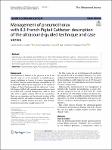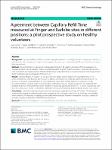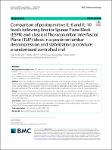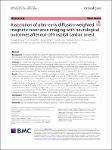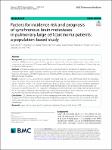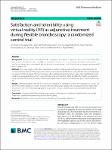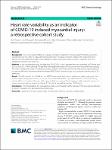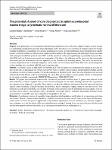Search
Author
- Daqing, Ma (3)
- Alexis, Ferré (2)
- Anna, Lybeck (2)
- Ashish K., Khanna (2)
- next >
Subject
- intensive care unit (8)
- acute respiratory dist... (5)
- chronic obstructive pu... (5)
- ICU (5)
- next >
Date issued
Has File(s)
Search Results
Spontaneous and traumatic pneumothorax are most often treated with chest tube (CT) thoracostomy. However, it appears that small-bore drainage systems have similar success rates with lower complications, pain, and discomfort for the patient. We present the description of the ultrasound-guided technique for pneumothorax drainage with an 8.3-French pigtail catheter (PC) in a case series of 10 patients. |
Capillary Refill Time (CRT) is a marker of peripheral perfusion usually performed at fingertip; however, its evaluation at other sites/position may be advantageous. Moreover, arm position during CRT assessment has not been fully standardized. |
Transversus abdominis plane (TAP) block can provide effective analgesia for abdominal surgery. However, it was questionable whether TAP had additional effect in the context of multimodal analgesia (MMA). Therefore, this study aimed to assess the additional analgesic effect of preoperative TAP block when added to MMA protocol in open gynecological surgery. |
The erector spinae plane block (ESPB) and classical thoracolumbar interfascial plane (TLIP) block can reduce postoperative pain in lumbar surgery. In this study, we compared the efficacy of ESPB and classical TLIP block in providing perioperative analgesia in patients undergoing lumbar posterior decompression and stabilization by comparing postoperative pain, opioid consumption, and IL-6 and IL-10 serum concentrations between ESPB and classical TLIP block. |
This study aimed to investigate the association between ultra-early (within 6 h after return of spontaneous circulation [ROSC]) brain diffusion-weighted magnetic resonance imaging (DW-MRI) and neurological outcomes in comatose survivors after out-of-hospital cardiac arrest. |
Patients with pulmonary large cell carcinoma (LCC) have a high incidence of synchronous brain metastases (SBM) and a poor prognosis. Our study was to evaluate the predictive and prognostic value of the clinical characteristics of pulmonary LCC patients with SBM at initial diagnosis by utilizing the Surveillance, Epidemiology, and End Results (SEER) database. |
This single-center preliminary prospective observational study used bedside ultrasound to assess the lung aeration modifications induced by recruitment maneuver and pronation in intubated patients with acute respiratory disease syndrome (ARDS) related to coronavirus 2019 disease (COVID-19). |
Patient comfort during invasive and therapeutic procedures is important. The use of virtual reality (VR) devices during flexible bronchoscopy (FB) as a method of distraction to increase patient tolerability and improve satisfaction has not been investigated. We aim to assess the satisfaction and tolerability of participants undergoing FB with or without VR. |
Heart rate variability (HRV) is a valuable indicator of autonomic nervous system integrity and can be a prognostic tool of COVID-19 induced myocardial affection. This study aimed to compare HRV indices between patients who developed myocardial injury and those without myocardial injury in COVID-19 patients who were admitted to intensive care unit (ICU). |
In the prehospital care of potentially seriously injured patients resource allocation adapted to injury severity (triage) is a challenging. Insufficiently specified triage algorithms lead to the unnecessary activation of a trauma team (over-triage), resulting in ineffective consumption of economic and human resources. A prehospital trauma triage algorithm must reliably identify a patient bleeding or suffering from significant brain injuries. By supplementing the prehospital triage algorithm with in-hospital established point-of-care (POC) tools the sensitivity of the prehospital triage is potentially increased. |

